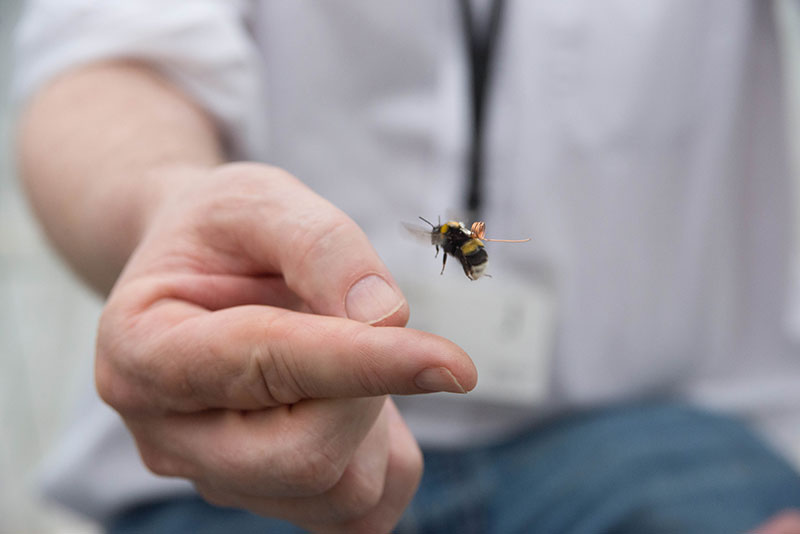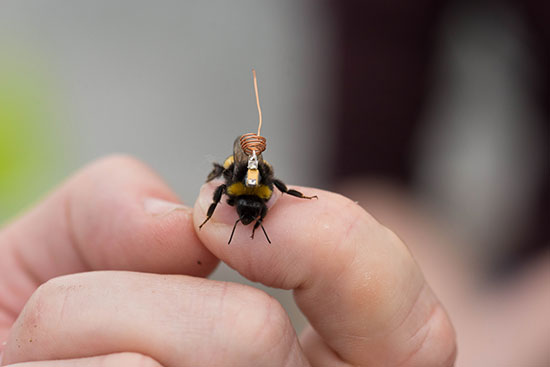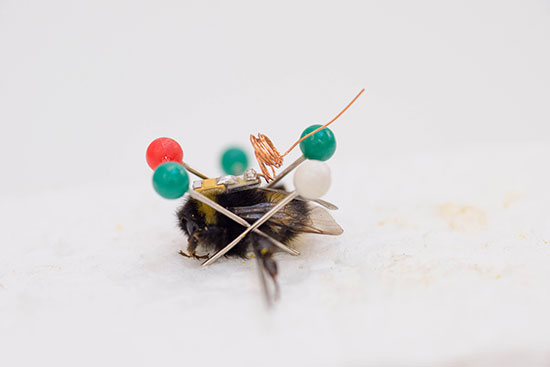Check Out These Teeny Homing Devices for Bees
Coming soon to a field near you:
Check Out These Teeny Homing Devices for Bees
Coming soon to a field near you:

Uncovering clues to the cause of colony collapse disorder, the mysterious disappearance of honeybees from millions of hives over the last decade, is one of the primary motivations for Barlow’s research. In order to track bee activity throughout the day, she and her colleagues Bruce Pavlik, a fellow ecologist, and Mark O’Neill, a computer engineer, have developed a tiny homing device that’s light enough to fit on a bumblebee’s back without restricting its ability to buzz about, forage for nectar, and carry on with typical bee behavior. (They hope to develop a device small enough for honeybees next.)
The device, known as an RFID (radio frequency identification) tag is modeled after similar equipment used to track everything from wolves in Yellowstone to cattle in a Nebraska feedlot to merchandise in electronics stores. When the tag is close enough to an electronic detection device, it’s presence is registered – whether it’s somebody trying to steal an iPhone, or a steer being moved from one pasture to another.
But Barlow envisions using RFID tags to register individual bees as they arrive at different flowers for a drink, return back at the hive, or perhaps, as they go off somewhere to die. Gleaning such data from large numbers of bees and coupling it with environmental data, such as weather, incidence of pesticide use, vegetation type and so on, will allow scientists to paint a much more detailed picture of bee life, and how agriculture and other human activities may be impacting it.
Existing RFID tags were far too bulky for bees to fly around with, which is where O’Neill, co-owner of the environmental technology company Tumbling Dice, came in. He joined forces in 2014 with Barlow and Pavlik at the Kew Botanic Gardens in London to develop a tiny insect homing device. Barlow, now a researcher at the University of Utah, recently discussed the new technology and its potential applications with Modern Farmer.

Modern Farmer: Other scientists have attempted to put RFID tags on bees before. What’s different about your approach?
Sarah Barlow: Previous insect RFID tags have a very small range of about 1 centimeter, so the detector unit must be placed in the hive so the bees that are tagged will pass it as they enter or leave. There is a trade-off between the size of the tag and its range, and the previous technology – to be small enough and light enough to be carried by a bee – could only be detected within 1 centimeter. Those devices couldn’t tell you where the bees have been in the landscape, only whether they return to the hive or not.
MF: How big is the tag you’ve been working on and what is its range?
SB: These new tags are 7 by 2 millimeters and have a detection range of just over 1 meter, which constitutes a real breakthrough in radio technology. They weigh 80 milligrams, which is about half the weight of a typical bumblebee. That seems to be the threshold weight and size that bees can fly and forage normally with. We looked at the behavior of the bees within a controlled glasshouse to see whether or not they were capable of flying with the tag on their back. The next step will be to take the experiment out into the field. That will be the acid test.
Bee behavior at the landscape scale is currently not well understood because it’s very difficult to track the movements of tiny flying insects.
MF: And what do you hope to accomplish with these itty-bitty tags?
SB: The purpose was to develop a new tracking system that was able to track the movements of small-bodied insects such as bees at the landscape scale, which hasn’t been done before. By putting the detecting units within flowering patches in the landscape and then looking at the movement patterns of the bees, you can effectively build a map of where they have been. And that could help you determine whether or not they are affected by habitat fragmentation, for example. But you could apply the technology to studying many aspects of their behavior to better understand how bees are responding to differences in the environment, such as pesticides and diseases. Bee behavior at the landscape scale is currently not well understood because it’s very difficult to track the movements of tiny flying insects.
MF: How exactly does one attach an RFID tag to the body of a bee?
SB: You chill them for about 10 minutes which makes them docile. Then you pin the insect down so it can’t move around and you use superglue to attach the tag. They recover very quickly.

MF: And none of this causes harm to the bee?
SB: No, no. We monitored them for about six weeks with their tags in the glasshouse, and they foraged and behaved normally within the glasshouse.
MF: What’s next in terms of making this technology widely available to those studying the issues affecting bee populations around the world?
SB: This particular project is about validating the proof of concept with the technology, which we have achieved. The next step is that we need the funding to develop the tags to the next level. We want to take it into the field and apply it to the ecological studies we are interested in, as well as to further optimize the technology to the point where it can be used much more widely by other scientists.
The critical point in developing the tags is that they have to be inexpensive; cheap enough for scientists to buy them in bulk.
MF: I’m assuming you can’t get the tags back from the bees and reuse them, so I suppose you need to be able to mass produce the tags at a low cost.
SB: Exactly. The critical point in developing the tags is that they have to be inexpensive; cheap enough for scientists to buy them in bulk. Because in all likelihood they will not come back and will have to be considered expendable.
MF: As an ecologist, what’s your opinion on the cause of colony collapse disorder? There seems to be so many theories that have circulated over the last number of years.
SB: It’s horrific for beekeepers to see their colonies disappear in such a short space of time, and you’re right, there are a lot of theories about it. It’s not entirely clear, but there are three main threats to insect pollinator populations around the world, including honeybees. Those are: change in land use – so reductions in habitat and forage availability for bees; pesticides; and pests and disease. But really it’s the interplay and interaction of all those stresses. It’s really very complex.
MF: Hopefully having this new and improved way to get inside the lives of bees will help.
SB: That’s where the research requirements are currently, where our knowledge gaps are – the question of how the interactions between these stresses are affecting bee populations. That’s where we are working towards more understanding and ultimately toward getting that scientific information into policy.
Don’t miss more stories from #beeweek! »
Follow us
This work is licensed under a Creative Commons Attribution-NoDerivatives 4.0 International License.
Want to republish a Modern Farmer story?
We are happy for Modern Farmer stories to be shared, and encourage you to republish our articles for your audience. When doing so, we ask that you follow these guidelines:
Please credit us and our writers
For the author byline, please use “Author Name, Modern Farmer.” At the top of our stories, if on the web, please include this text and link: “This story was originally published by Modern Farmer.”
Please make sure to include a link back to either our home page or the article URL.
At the bottom of the story, please include the following text:
“Modern Farmer is a nonprofit initiative dedicated to raising awareness and catalyzing action at the intersection of food, agriculture, and society. Read more at <link>Modern Farmer</link>.”
Use our widget
We’d like to be able to track our stories, so we ask that if you republish our content, you do so using our widget (located on the left hand side of the article). The HTML code has a built-in tracker that tells us the data and domain where the story was published, as well as view counts.
Check the image requirements
It’s your responsibility to confirm you're licensed to republish images in our articles. Some images, such as those from commercial providers, don't allow their images to be republished without permission or payment. Copyright terms are generally listed in the image caption and attribution. You are welcome to omit our images or substitute with your own. Charts and interactive graphics follow the same rules.
Don’t change too much. Or, ask us first.
Articles must be republished in their entirety. It’s okay to change references to time (“today” to “yesterday”) or location (“Iowa City, IA” to “here”). But please keep everything else the same.
If you feel strongly that a more material edit needs to be made, get in touch with us at [email protected]. We’re happy to discuss it with the original author, but we must have prior approval for changes before publication.
Special cases
Extracts. You may run the first few lines or paragraphs of the article and then say: “Read the full article at Modern Farmer” with a link back to the original article.
Quotes. You may quote authors provided you include a link back to the article URL.
Translations. These require writer approval. To inquire about translation of a Modern Farmer article, contact us at [email protected]
Signed consent / copyright release forms. These are not required, provided you are following these guidelines.
Print. Articles can be republished in print under these same rules, with the exception that you do not need to include the links.
Tag us
When sharing the story on social media, please tag us using the following: - Twitter (@ModFarm) - Facebook (@ModernFarmerMedia) - Instagram (@modfarm)
Use our content respectfully
Modern Farmer is a nonprofit and as such we share our content for free and in good faith in order to reach new audiences. Respectfully,
No selling ads against our stories. It’s okay to put our stories on pages with ads.
Don’t republish our material wholesale, or automatically; you need to select stories to be republished individually.
You have no rights to sell, license, syndicate, or otherwise represent yourself as the authorized owner of our material to any third parties. This means that you cannot actively publish or submit our work for syndication to third party platforms or apps like Apple News or Google News. We understand that publishers cannot fully control when certain third parties automatically summarize or crawl content from publishers’ own sites.
Keep in touch
We want to hear from you if you love Modern Farmer content, have a collaboration idea, or anything else to share. As a nonprofit outlet, we work in service of our community and are always open to comments, feedback, and ideas. Contact us at [email protected].by Brian Barth, Modern Farmer
June 14, 2016
Modern Farmer Weekly
Solutions Hub
Innovations, ideas and inspiration. Actionable solutions for a resilient food system.
ExploreExplore other topics
Share With Us
We want to hear from Modern Farmer readers who have thoughtful commentary, actionable solutions, or helpful ideas to share.
SubmitNecessary cookies are absolutely essential for the website to function properly. This category only includes cookies that ensures basic functionalities and security features of the website. These cookies do not store any personal information.
Any cookies that may not be particularly necessary for the website to function and are used specifically to collect user personal data via analytics, ads, other embedded contents are termed as non-necessary cookies.